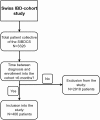Effect of distance to specialist care for the diagnosis and disease outcome of inflammatory bowel disease in the Swiss inflammatory bowel disease cohort study
- PMID: 32047533
- PMCID: PMC6984432
- DOI: 10.1177/1756284819895217
Effect of distance to specialist care for the diagnosis and disease outcome of inflammatory bowel disease in the Swiss inflammatory bowel disease cohort study
Abstract
Background: Inflammatory bowel disease (IBD) needs early interventions and an individual specialist-patient relationship. Distance from a tertiary IBD center might affect patient's disease course and outcome. We investigated whether the patient-to-specialist distance has an impact on the disease course using the well-defined patient collective of the Swiss Inflammatory Bowel Disease Cohort Study (SIBDCS).
Methods: Patient's home address at diagnosis (postal zip code) was extracted from the SIBDCS database. Distance between each zip code and the nearest located IBD specialist center was calculated and classified into the following three sections based on proximity: <10 km (group 1); 10-35 km (group 2); >35 km (group 3).
Results: Our study included in total 408 IBD patients [234 Crohn's disease (CD), 154 ulcerative colitis (UC), 20 IBD unclassified (IBDU)]. Median age was lowest in group 2 at diagnosis (G1: 28 years; G2: 21 years, G3: 26 years, p < 0.01). The diagnostic delay did not differ between groups. CD patients in group 1 were treated more often with anti-tumor necrosis factor (TNF) agents (72% versus 56%, p = 0.04) and 5-aminosalicylates (44% versus 28%, p = 0.04) than in group 3. UC/IBDU patients in group 1 were treated more often with corticosteroids than patients in group 3 (83% versus 58%, p < 0.01). The occurrence of IBD-related surgeries did not differ between groups.
Conclusions: Patient-to-specialist distance might affect drug treatment. However, disease course and the need for IBD-related surgery does not seem to be associated with a longer distance to specialist care in Switzerland.
Keywords: diagnostic delay; disease outcome; tertiary care.
© The Author(s), 2020.
Conflict of interest statement
Conflict of interest: The authors declare that there is no conflict of interest.
Figures


Similar articles
-
Disease course of inflammatory bowel disease unclassified in a European population-based inception cohort: An Epi-IBD study.J Gastroenterol Hepatol. 2019 Jun;34(6):996-1003. doi: 10.1111/jgh.14563. Epub 2019 Jan 21. J Gastroenterol Hepatol. 2019. PMID: 30562421
-
Occurrence of skin manifestations in patients of the Swiss Inflammatory Bowel Disease Cohort Study.PLoS One. 2019 Jan 25;14(1):e0210436. doi: 10.1371/journal.pone.0210436. eCollection 2019. PLoS One. 2019. PMID: 30682031 Free PMC article.
-
The appearance of joint manifestations in the Swiss inflammatory bowel disease cohort.PLoS One. 2019 Apr 30;14(4):e0211554. doi: 10.1371/journal.pone.0211554. eCollection 2019. PLoS One. 2019. PMID: 31039159 Free PMC article.
-
Visceral adiposity and inflammatory bowel disease.Int J Colorectal Dis. 2021 Nov;36(11):2305-2319. doi: 10.1007/s00384-021-03968-w. Epub 2021 Jun 9. Int J Colorectal Dis. 2021. PMID: 34104989 Review.
-
An Overview of Inflammatory Bowel Disease Unclassified in Children.Inflamm Intest Dis. 2019 Aug;4(3):97-103. doi: 10.1159/000501519. Epub 2019 Jul 19. Inflamm Intest Dis. 2019. PMID: 31559261 Free PMC article. Review.
Cited by
-
Diagnostic Delay of Inflammatory Bowel Disease Is Significantly Higher in Public versus Private Health Care System in Mexican Patients.Inflamm Intest Dis. 2021 Dec 6;7(2):72-80. doi: 10.1159/000520522. eCollection 2022 Jul. Inflamm Intest Dis. 2021. PMID: 35979192 Free PMC article.
-
Evaluating Distance Bias in Chronic Rhinosinusitis Outcomes.JAMA Otolaryngol Head Neck Surg. 2022 Jun 1;148(6):507-514. doi: 10.1001/jamaoto.2022.0268. JAMA Otolaryngol Head Neck Surg. 2022. PMID: 35511170 Free PMC article.
References
-
- Burisch J, Munkholm P. Inflammatory bowel disease epidemiology. Curr Opin Gastroenterol 2013; 29: 357–362. - PubMed
-
- Molodecky NA, Soon IS, Rabi DM, et al. Increasing incidence and prevalence of the inflammatory bowel diseases with time, based on systematic review. Gastroenterology 2012; 142: 46–54.e42; quiz e30. - PubMed
-
- Benchimol EI, Fortinsky KJ, Gozdyra P, et al. Epidemiology of pediatric inflammatory bowel disease: a systematic review of international trends. Inflamm Bowel Dis 2011; 17: 423–439. - PubMed
-
- Boonen A, Dagnelie PC, Feleus A, et al. The impact of inflammatory bowel disease on labor force participation: results of a population sampled case-control study. Inflamm Bowel Dis 2002; 8: 382–389. - PubMed
LinkOut - more resources
Full Text Sources

